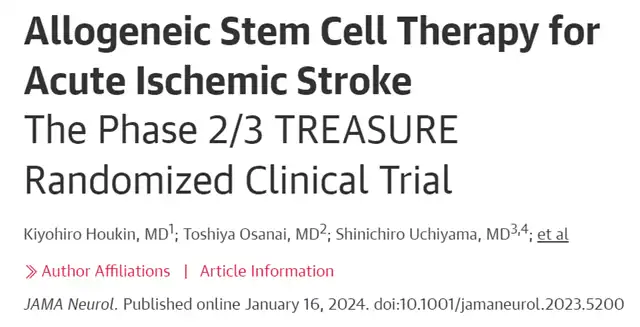MultiStem Cell Therapy for Acute Stroke: JAMA Neurology Insights
- Normal Liver Cells Found to Promote Cancer Metastasis to the Liver
- Nearly 80% Complete Remission: Breakthrough in ADC Anti-Tumor Treatment
- Vaccination Against Common Diseases May Prevent Dementia!
- New Alzheimer’s Disease (AD) Diagnosis and Staging Criteria
- Breakthrough in Alzheimer’s Disease: New Nasal Spray Halts Cognitive Decline by Targeting Toxic Protein
- Can the Tap Water at the Paris Olympics be Drunk Directly?
MultiStem Cell Therapy for Acute Stroke: JAMA Neurology Insights
- Should China be held legally responsible for the US’s $18 trillion COVID losses?
- CT Radiation Exposure Linked to Blood Cancer in Children and Adolescents
- FDA has mandated a top-level black box warning for all marketed CAR-T therapies
- Can people with high blood pressure eat peanuts?
- What is the difference between dopamine and dobutamine?
- How long can the patient live after heart stent surgery?
MultiStem Cell Therapy for Acute Stroke: JAMA Neurology Insights
Stroke stands as the second leading cause of global mortality and a major contributor to disability.
Reperfusion therapies, such as intravenous thrombolysis and mechanical thrombectomy, are common approaches to treating stroke.
However, their efficacy varies, with around 50% of patients experiencing disabilities three months post-stroke. Consequently, there is a pressing clinical need to develop new treatment strategies and expand the treatment window.
Cell therapy emerges as a promising avenue for treating stroke and other diseases. MultiStem, an allogeneic bone marrow-derived multipotent adult progenitor cell product, exhibits potential in reducing inflammation, regulating immune imbalances, protecting damaged cells, promoting blood vessel generation, tissue repair, and healing. Nevertheless, there is a scarcity of randomized controlled trials assessing the effectiveness of MultiStem in stroke treatment.
A recent study published in JAMA Neurology, titled “Allogeneic Stem Cell Therapy for Acute Ischemic Stroke: The Phase 2/3 TREASURE Randomized Clinical Trial,” investigated the efficacy and safety of intravenous administration of MultiStem within 18 to 36 hours after an ischemic stroke episode.

The multicenter, randomized, double-blind, parallel-group, placebo-controlled phase 2/3 clinical trial conducted in 44 academic and clinical centers in Japan from November 15, 2017, to March 29, 2022, enrolled 206 patients aged 20 and above. These patients presented with acute ischemic stroke accompanied by persistent neurological deficits, confirmed acute infarcts involving the cerebral cortex with a longitudinal axis measurement greater than 2 cm (determined by diffusion-weighted magnetic resonance imaging [DW-MRI]), and a pre-stroke modified Rankin Scale (mRS) score of 0 or 1. Participants were randomly assigned in a 1:1 ratio to the MultiStem group (1.2 billion cells/unit, n=104) or the placebo group (n=102). The average age of the included patients was 76.5 years, with 112 (54.4%) being male and 94 (45.6%) female.
The primary efficacy outcome was the proportion of patients with a favorable outcome at day 90 (defined as a composite of mRS score ≤1, NIHSS score ≤1, and Barthel Index score ≥95). Key secondary endpoints included the proportion of patients with a favorable outcome at day 365, distribution of mRS scores at days 90 and 365, and the proportion of patients with mRS scores of 0–1 and 0–2 at day 90.
No significant difference in the proportion of patients with a favorable outcome at day 90 was observed between the MultiStem and placebo groups (12 cases [11.5%] vs. 10 cases [9.8%], P=0.90; adjusted risk difference, 0.5% [95% CI, -7.3% to 8.3%]). Furthermore, there were no statistically significant differences in any of the key secondary endpoints between the two groups.
In exploratory subgroup analyses, patients in the MultiStem group with ischemic core volumes of 50 mL or less exhibited significantly better outcomes compared to the placebo group (8 cases out of 27 [29.6%] vs. 3 cases out of 37 [8.1%], P=0.04). Additionally, patients aged 64 or younger in the MultiStem group tended to have better outcomes compared to the placebo group (8 cases out of 10 [80.0%] vs. 5 cases out of 12 [41.7%], P=0.08). Although these subgroup analysis results have potential statistical diversity, researchers did not observe these benefits in patients with ischemic core volumes less than 50 mL, regardless of the volume threshold (25 mL or less, 25 mL or more, less than 70 mL, 70 mL or more) and in patients aged 65 or older, 74 or younger, and 75 or older.
The main safety endpoint, including grade 3 or 4 infusion-related allergic reactions, showed no difference between the two groups. Adverse events related to the study drug occurred in 31 patients (29.8%) receiving MultiStem treatment and 12 patients (11.8%) receiving placebo treatment.
In summary, this randomized clinical trial demonstrated that intravenous administration of allogeneic cell therapy within 18 to 36 hours after an ischemic stroke is safe but does not improve short-term outcomes. Researchers emphasize the need for further investigation to determine whether MultiStem treatment for ischemic stroke is beneficial for patients meeting specific criteria.
Reference: Houkin K, et al., (2024). Allogeneic Stem Cell Therapy for Acute Ischemic Stroke: The Phase 2/3 TREASURE Randomized Clinical Trial. JAMA Neurol, doi: 10.1001/jamaneurol.2023.5200.
MultiStem Cell Therapy for Acute Stroke: JAMA Neurology Insights
Reference:
[1] Houkin K, et al., (2024). Allogeneic Stem Cell Therapy for Acute Ischemic Stroke: The Phase 2/3 TREASURE Randomized Clinical Trial. JAMA Neurol, doi: 10.1001/jamaneurol.2023.5200.
(source:internet, reference only)
Disclaimer of medicaltrend.org
Important Note: The information provided is for informational purposes only and should not be considered as medical advice.



